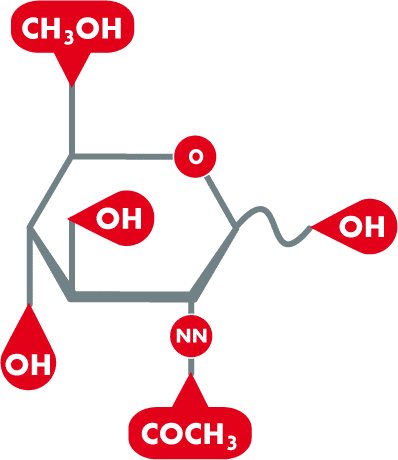N-Acetylglucosamine
N-acetylglucosamine (abbreviated NAG) is an endogenous sugar building block found in human tissue. As a derivative of glucose, NAG serves as a central metabolic product of our organism. As a component of biopolymers, it is found, for example, in the chitin of crustaceans or in the cell membrane of fungi and bacteria. In the cosmetic context, NAG is of great interest because, in addition to glucuronic acid, it forms the well-known hyaluronic acid as a further sugar molecule.
The advantages of NAG in cosmetics
Hyaluronic acid has an important biological function in human skin. It is the main component of the extracellular matrix and is formed in the cell membranes and is therefore a natural component of the skin. N-acetylglucosamine is the main component of hyaluronic acid in the skin, which is essential for skin hydration and skin barrier.
The percentage of hyaluronic acid decreases with age, reducing the skin’s moisture-binding capacity. As part of hyaluronic acid, NAG stimulates the synthesis of this skin-own polymer. As a result, NAG promotes the body’s own hyaluronic acid production, which is directly related to skin hydration. However, the molecular properties of NAG also favor penetration into the skin, enabling the binding of water in deeper skin layers.
Another positive effect is found in the reduction of hyperpigmentation. NAG inhibits the enzyme tyrosinase, which is involved in the formation of the skin pigment melanin. Hyperpigmentation in the form of pimple marks or sun-related skin changes is reduced and the complexion appears more even.
Environmental influences such as UV rays trigger damage to our skin cells. N-acetylglucosamine binds the free radicals induced by UV rays and thus counteracts skin aging.
NAG also has a supporting function in connection with cornification disorders. N-acetylglucosamine reduces the cohesion between the dead skin cells of the horny layer, which facilitates the removal of the horny skin cells. Due to the desquamation of the dead skin cells, the skin texture appears refined and smoother. People with sensitive skin, rosacea or chafed skin can use products with NAG instead of chemical peelings (e.g. AHA), as NAG is a skin-friendly alternative.
Effect of N-acetylglucosamine
The NAG is already well researched and combined with other active ingredients provides an even skin appearance. Niacinamide is proven to have lightening effects, which in combination with 1-4% N-acetylglucosamine counteract skin pigmentation to a greater extent. Likewise, the combination of N-acetylglucosamine and hyaluron can effectively improve the moisturizing effect. Even 1% NAG contributes to improved hydration of the skin and reduced cornification disorder. N-acetylglucosamine is therefore often used as a moisturizing active ingredient or as a compatible exfoliant. For an even skin appearance, NAG can be used against eye shadows and pimple marks in creams.
Fact Sheet N-acetylglucosamine
INCI: Acetyl Glucosamine
Alternative names: N-Acetyl-D-Glucosamine, NAG, N-acetylglucosamine
CAS number: 7512-17-6
EINECS number: 231-165-9
Description: Odorless, white to whitish, crystalline powder.
We like to work with these NAG-containing active ingredients:
| Name | Company Name | INCI | Remark |
|---|---|---|---|
| N-Acetyl-D-Glucosamine | Sandream Specialties | Acetyl Glucosamine | |
| Skin'ential HA | MMP Europe | Acetyl Glucosamine | |
| Skin'ential HA-FE | MMP Europe | Acetyl Glucosamine | |
| SpecKare NADG | Spec-Chem Industry Inc | Acetyl Glucosamine | |
| Hyafactor-NAG | Bloomage Biotechnology Corp., Ltd. | Acetyl Glucosamine | |
| SpecKare NADG | Spec-Chem Industry Inc | Acetyl Glucosamine | |
| NovHyal Biotech G | Givaudan Active Beauty | Glycerin , Aqua , Disodium Acetyl Glucosamine Phosphate | |
| Tightenyl | Givaudan Active Beauty | Glycerin , Water , Disodium Acetyl Glucosamine Phosphate , Sodium Glucuronate , Magnesium Sulfate | |
| Erasyal | Givaudan Active Beauty | Aqua , Glycerin , Disodium Acetyl Glucosamine Phosphate , Caffeyl Glucoside | |
| WhiteTen | BioSpectrum, Inc. | Niacinamide , Acetyl Glucosamine , Centella Asiatica Extract , Morus Alba Bark Extract , Pyrus Malus (Apple) Fruit Extract , Camellia Sinensis Leaf Extract , Broussonetia Kazinoki Root Extract , Ergosterol , Galactoarabinan , Camellia Japonica Leaf Extract | |
| PANTROFINA NMF | Res Pharma Industriale | Aqua , Sodium PCA , Mel , Urea , Fructose , Glucose , Pentylene Glycol , Citric Acid , Glycine , Acetyl Glucosamine , Glucuronolactone , Lysine HCl , Propylene Glycol , Hydrolyzed Collagen , 1,2-Hexanediol , Caprylyl Glycol , Tropolone |
Cosmetic products containing N-acetylglucosamine
N-acetylglucosamine is a well-researched and effective active ingredient that has many positive effects on the skin condition. It provides hydration of the skin with its moisturizing effect. For an even, smooth and radiant skin, N-acetylglucosamine gently supports the removal of skin flakes. Especially in combination with niacinamide or hyaluronic acid an increased effect is achieved. Due to this, the use of N-acetylglucosamine is well suited for sensitive, dry and flaky skin.
We at Cosmacon develop high-quality and modern cosmetics for you, just contact us!
Sources:
N-acetylglucosamine: production and applications.; Chen J; Shen C; Liu C. Marine drugs, 2010, 8. Jg., Nr. 9, S. 2493-2516.
Nanostructured Lipid Carrier for Topical Application of N-Acetyl Glucosamine.; Aliasgharlou L, Ghanbarzadeh S, Azimi H, Zarrintan MH, Hamishehkar H. Adv Pharm Bull. 2016 Dec;6(4):581-587.
Postinflammatory hyperpigmentation: a review of the epidemiology, clinical features, and treatment options in skin of color.; Davis EC, Callender VD.J Clin Aesthet Dermatol. 2010 Jul;3(7):20-31.
Reduction in the appearance of facial hyperpigmentation after use of moisturizers with a combination of topical niacinamide and N-acetyl glucosamine: results of a randomized, double-blind, vehicle-controlled trial.; Kimball AB, et al. Br J Dermatol. 2010. PMID: 19845667 Clinical Trial.
Reduction in the appearance of facial hyperpigmentation after use of moisturizers with a combination of topical niacinamide.; Randomized Controlled Trial 2010 Feb 1;162(2):435-41.
Glucosamine: an ingredient with skin and other benefits.; Donald L Bissett. 2006. 5(4): 309–315.
Determination of N-acetylglucosamine in cosmetic formulations and skin test samples by hydrophilic interaction liquid chromatography and UV detection.; Alice Pedrali, Mariella Bleve, Priscilla Capra, Tobias Jonsson, Gabriella Massolini, Paola Perugini, Giorgio Marrubini, Journal of Pharmaceutical and Biomedical Analysis, 2015, 107. Jg.: 125-130.
